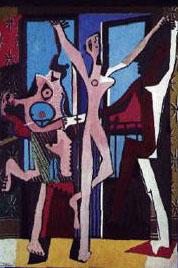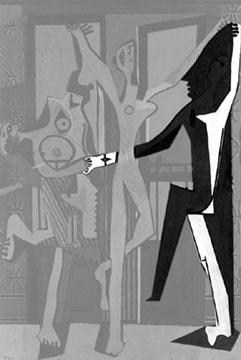|
|
The Three Dancers |
|
 If you've found this site useful, we'd really appreciate a small donation to help with the hosting costs. Thanks! |
The 'Three Dancers' of 1925 is Picasso's most celebrated Surrealist painting; it heralded a violence in his art that has been linked to the deterioration of his marriage with Olga Koklova.
The positioning of the three figures in each picture is more or less identical and both strongly evoke the theme of Crucifixion in marital conflict. The Three Dancers is also full of concealed imagery, nearly all of which has gone unrecognised by Picasso historians.
In 1966, Ronald Alley, a former keeper at the Tate Gallery wrote a well known study of the 'Three Dancers'. In it he based important points in his argument on conversations that took place between Picasso and Roland Penrose in 1965. In these conversations, Picasso said things about The Three Dancers that are quite untrue, but both Penrose and Ally assumed otherwise and as a consequence they have helped disseminate what appears to be a deliberate programme of misinformation in respect of this famous painting.
From surviving photographs and portraits of Ramon Pichot from 1899 onwards it becomes apparent that the dark profile in The Three Dancers does not resemble him at all. Pichot always sported a large distinctive beard, which the profile does not show.
The mysterious profile reappears in a portrait of a seated female, in 1925, entitled 'La Statuaire' as well as on the right of the 1934 drawing. It seems from this to be a cryptic reference to Olga and the Harlequin, and not Ramon Pichot. Picasso was known to be deceptive about the meanings in his work and was not above telling lies if it suited him. In order to prevent Olga and others identifying the sensitive subject matter in some of his paintings, he sometimes found it necessary to adopt disguises. In the same conversations with Penrose in 1965, Picasso twice denied making any drawings similar to The Three Dancers after 1925, even though his wife contradicted him by claiming to have seen drawings connected with it. All this exposes what seems to be a deliberate subterfuge in which Picasso was still keeping the 1934 drawing a secret, over thirty years after its completion. It appears from the conversations that he may have been concealing other related drawings as well. Because the 1934 drawing contains a deliberately concealed fingerprint and has a close symbolic connection to a range of Picasso's most acclaimed masterpieces, he may have intended it to come to light after his death and provide a key to understanding previously misunderstood, yet deeply significant meanings in his art. It would have been entirely characteristic of Picasso to have devised such a plan, if it had a subversive effect on 'established' history. Picasso was, after all, a dedicated anarchist. Further Reading: Ronald Alley, Picasso, The Three Dancers, Tate Modern Masterpieces, The Tate Gallery 1986.
© Mark Harris 1996, 1997 Related Picassos
Next Section: Themes of the 1934 Drawing |
|
|
|
     |
     |
|
|
© Mark Harris 1996 (content), Simon Banton 1996 (design) In general copyright of works by Pablo Picasso are the property of the heirs to the Pablo Picasso estate |
|

 The 1934 drawing is closely related to the 'Three Dancers' in composition.
The 1934 drawing is closely related to the 'Three Dancers' in composition. The misinformation revolves around two points. Firstly, that the black profile on the far right of the painting represents his friend Ramon Pichot, who died at the time Picasso was painting the picture. And, secondly, that Picasso created no other pictures similar to the 'Three Dancers' after 1925.
The misinformation revolves around two points. Firstly, that the black profile on the far right of the painting represents his friend Ramon Pichot, who died at the time Picasso was painting the picture. And, secondly, that Picasso created no other pictures similar to the 'Three Dancers' after 1925.